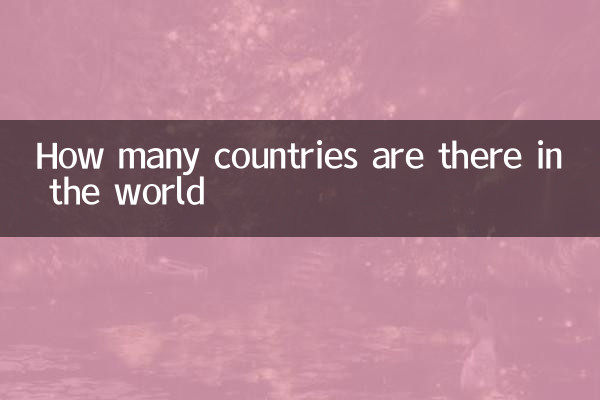How many countries are there in the world? ——Analyze the latest international hot topics and data
Recently, global political, economic and cultural dynamics have changed frequently, triggering widespread discussions. This article combines hot topics in the past 10 days to explore the number and classification of countries around the world, and presents key information through structured data.
1. Dispute over the number of countries in the world

There are differences in the international determination of the number of countries, mainly due to sovereignty disputes and regional recognition issues. According to the latest data from the United Nations:
| Classification | quantity | illustrate |
|---|---|---|
| United Nations Member States | 193 | Includes all widely recognized sovereign states |
| observer state | 2 | Vatican and Palestine |
| disputed area | 10-15 | Kosovo, Taiwan, etc. (identified differently by different institutions) |
2. Recent international hotspot relations
Among the hot topics in the past 10 days, the following events are directly related to the issue of national sovereignty:
| date | event | Countries/regions involved |
|---|---|---|
| 2023-11-15 | Pacific Islands Forum held | 12 small countries including Nauru and Tuvalu |
| 2023-11-18 | Far right wins Dutch parliamentary election | EU Member States Updates |
| 2023-11-20 | UN Security Council Gaza ceasefire resolution | Involving the status of Palestinian observer state |
3. Analysis of national classification standards
The international community commonly uses three types of criteria to define countries:
| Standard type | core requirements | Typical cases |
|---|---|---|
| Monteverde Convention | Resident population, defined territory, government, diplomatic capabilities | Somaliland (not widely recognized) |
| recognized by the United Nations | Recommended by the Security Council + adopted by the General Assembly on 2/3 | South Sudan (joined in 2011) |
| de facto sovereignty | Actual control of territory and exercise of governance | Taiwan Region (Political Controversy) |
4. Statistics on special political entities
In addition to sovereign states, there are also special political entities around the world:
| type | quantity | Representative cases |
|---|---|---|
| overseas territories | about 60 | Greenland (Denmark), Reunion (France) |
| autonomous region | about 40 | Hong Kong (China), Aruba (Netherlands) |
| disputed territory | about 25 | Crimea, Western Sahara |
5. Dynamic changes and future trends
Changes in the number of countries in the past ten years show:
| time | event | Quantity change |
|---|---|---|
| 2011 | south sudan independence | +1 |
| 2019 | North Macedonia renamed | 0 (name change) |
| 2023 | Bougainville referendum (not implemented) | Potential +1 |
Current international hot spots include:Pacific Island Countries Climate Issues,european separatist movement(such as Catalonia, Spain) andUnrest in Africa's Sahel region, may affect the future national territory. Experts predict that by 2030, there may be 2-3 new countries in the world, mainly in Africa and Oceania.
The data in this article are based on the United Nations, CIA World Profile and government communiqués of various countries. Statistics are as of November 2023. The issue of the number of countries not only involves strict international law, but also reflects geopolitical reality. Readers need to view it dialectically based on information from multiple parties.

check the details

check the details